Level V
Study Page
This
online lesson program is not intended to be a substitute for riding lessons,
instead is is intended to be a thorough introduction for non-riders and a
valuable educational tool to riders. Horses can be unpredictable at times
and can cause harm to inexperienced handlers, please seek a professional
instructor or trainer when applying your knowledge learned during this online
lesson program.
1.
Basic nutritional needs of the horse
Water
 Clean
water must be available at all times. An average horse will consume up
to 12 gallons of water daily, and even more when active. In the
winter horses prefer to drink warm (45-65 degrees) water. Horses can not eat enough snow to
have adequate water consumption.
Pasture
Clean
water must be available at all times. An average horse will consume up
to 12 gallons of water daily, and even more when active. In the
winter horses prefer to drink warm (45-65 degrees) water. Horses can not eat enough snow to
have adequate water consumption.
Pasture
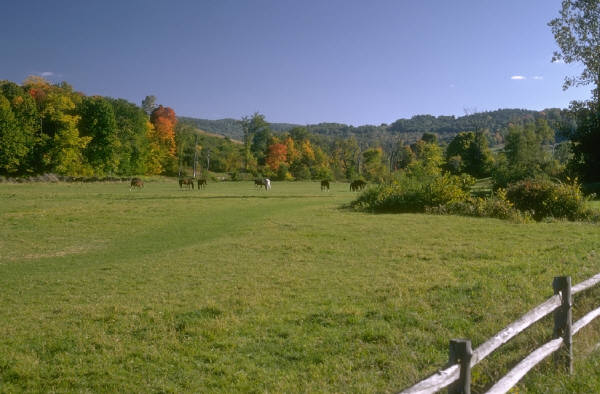 Good
quality pasture is always a great way to provide nutrition to a horse.
Although even on high quality pasture horses should be given a mineral
supplement. Horses on pasture only should be monitored closely for
weight loss and supplemented with hay and grain when the pasture is
going dormant or is over grazed.
Hay
Good
quality pasture is always a great way to provide nutrition to a horse.
Although even on high quality pasture horses should be given a mineral
supplement. Horses on pasture only should be monitored closely for
weight loss and supplemented with hay and grain when the pasture is
going dormant or is over grazed.
Hay
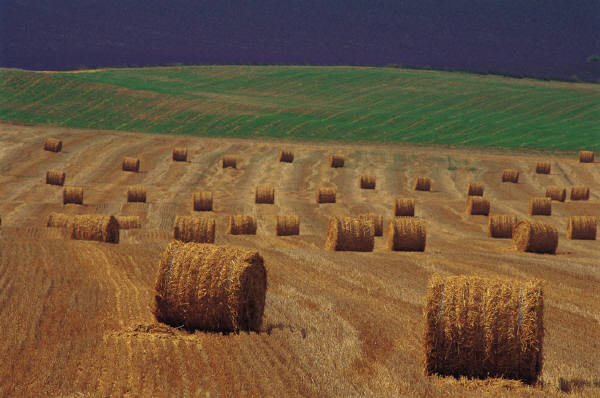 An
average horse
eats about 10-15 pounds of hay daily (less if grazing on good quality
pasture). Two hay choices are available: grass hay and
legume hay. The most common hays fed are alfalfa (which is a legume
hay) and mixed grass hay. Alfalfa is high in protein and is
suitable for horse with extremely high energy demands. Grass hay
is lower in protein and is more suitable for average horses. Most grass hay can be fed free choice (unlimited
amount). Since horses require a high amount of roughage, high quality
grass hay is preferable. Of course each horse is an individual, some
horses may need restricted diets even on grass hay.
Grain
A fortified grain
mix can be fed in controlled quantities, based on horse's weight, age, and
activity level. Horses can not be fed grain free choice as they can
over eat and this can create a life threatening condition. Mature horses that are not active might not require
grain, although a good mineral supplement is required.
Minerals
Free
choice salt should be available for all horses or a mineral supplement for
horses fed only hay.
Some mineral supplements are not intended for horse consumption, only
feed horse specific supplements and salt blocks.
Frequency
An
average horse
eats about 10-15 pounds of hay daily (less if grazing on good quality
pasture). Two hay choices are available: grass hay and
legume hay. The most common hays fed are alfalfa (which is a legume
hay) and mixed grass hay. Alfalfa is high in protein and is
suitable for horse with extremely high energy demands. Grass hay
is lower in protein and is more suitable for average horses. Most grass hay can be fed free choice (unlimited
amount). Since horses require a high amount of roughage, high quality
grass hay is preferable. Of course each horse is an individual, some
horses may need restricted diets even on grass hay.
Grain
A fortified grain
mix can be fed in controlled quantities, based on horse's weight, age, and
activity level. Horses can not be fed grain free choice as they can
over eat and this can create a life threatening condition. Mature horses that are not active might not require
grain, although a good mineral supplement is required.
Minerals
Free
choice salt should be available for all horses or a mineral supplement for
horses fed only hay.
Some mineral supplements are not intended for horse consumption, only
feed horse specific supplements and salt blocks.
Frequency
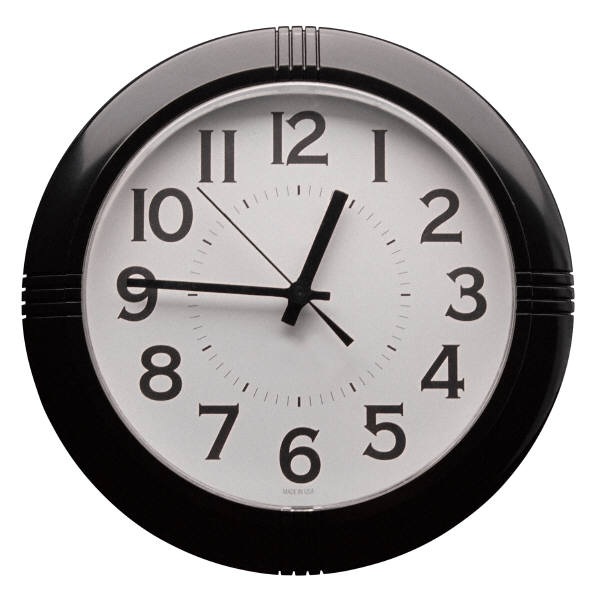 Horses
are grazing animals and should be fed at least twice daily to help
simulate their natural eating habits. This will encourage a
healthy digestive tract and help cut down on the instances of colic.
Horses
are grazing animals and should be fed at least twice daily to help
simulate their natural eating habits. This will encourage a
healthy digestive tract and help cut down on the instances of colic.
2.
Caring for tack
Tack should be kept
very clean and not allowed to dry out and become brittle. Most tack is
made out of leather and must be cleaned regularly and oiled to keep moisture
in it. Every time a piece of tack is used, whether it be a bridle,
halter, or saddle, inspect it to make sure it is in good, safe working
order. If you notice cracks or tears in the leather do not use it
until it is repaired. Weekly cleaning with Murphy's oil soap (or other
similar product) is crucial. Simply take a small damp sponge (wring
out most of the water) and put a small amount of soap on it and work it into
the leather. If your tack has dirt or mud on it repeat procedure until
all traces of dirt are gone. Then simply wipe with a clean cloth.
Do not get leather extremely wet. About once a month (or less
frequently) you can
apply a light coating of leather oil or conditioner, making sure not
to get this on the seat if it is suede. If you have a show saddle that is light in
color you must be very careful when cleaning, too much moisture will darken
the finish. Special products are available for light colored leather.
It is best to keep show tack well covered when not is use to keep it dust
free.
Some girths and
cinches are made out of leather, in this case simply keep clean as directed
above. Others are made out of cord. These girths must be kept
very clean as they cause sores easily. Fleece covers can be used over
leather or cord adding protection, and they can be easily cleaned by
throwing them in the wash. Even nylon girths or cinches are available
with fleece sewn on one side, these too can usually be machine washed.
Neoprene cinches and girths are the easiest to take care of and can be hosed
off everyday and hung to dry.
Saddle pads should
be laundered regularly depending on how much you ride. Some pads made
of neoprene or similar material just need sprayed off with a hose and hung
to dry, other pads can be washed in a washing machine. If you have a
pad that is not machine washable it is a good idea to use a saddle pad liner
that can easily cleaned. You don't want the pad to be "crusty" on the
underside where it is on the horse, this can cause irritation on the horse's
back.
3.
Basic western class descriptions
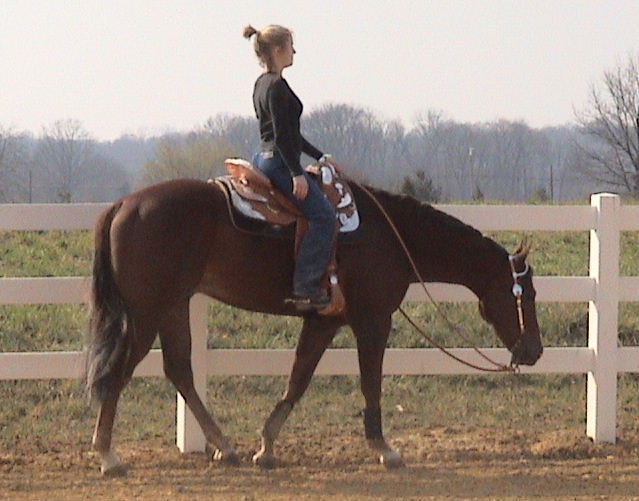 WESTERN PLEASURE
Participants are in the arena together, and are
asked to walk, jog, lope and reverse at the direction of the judge.
While being judged, the horses stay on the perimeter of the arena and
then are usually brought to the middle of the arena to back for the
judge. Horses are evaluated on how well they move and how willingly
they accept commands from their riders. Horse are shown on a loose rein
at a slow rate of speed while maintaining a balanced gait.
WESTERN HORSEMANSHIP
The rider, not the horse is judged in this event.
First the riders complete a prescribed pattern individually at the walk,
trot or lope. Then they ride as a group similar to in the western
pleasure class. The riderís body position and control of their horse are
evaluated. The pattern should be executed with grace and ease. There
rider should make the performance look effortless.
TRAIL
Participants perform individually in this class.
Horses are guided through an obstacle course by their riders. Some
examples are: negotiating a gate while mounted; walking, trotting, or
loping over ground poles; backing through poles or cones; and side
passing over or around objects. Smoothness and ease of performance are
evaluated.
REINING
In this class horses perform individually.
Participants are required to follow a set pattern consisting of circles,
straight lines, stops, spins, and roll-backs. This is a fast paced
event that requires great almost invisible communication between the
horse and rider. The horse must follow directions quickly without
hesitation.
WESTERN PLEASURE
Participants are in the arena together, and are
asked to walk, jog, lope and reverse at the direction of the judge.
While being judged, the horses stay on the perimeter of the arena and
then are usually brought to the middle of the arena to back for the
judge. Horses are evaluated on how well they move and how willingly
they accept commands from their riders. Horse are shown on a loose rein
at a slow rate of speed while maintaining a balanced gait.
WESTERN HORSEMANSHIP
The rider, not the horse is judged in this event.
First the riders complete a prescribed pattern individually at the walk,
trot or lope. Then they ride as a group similar to in the western
pleasure class. The riderís body position and control of their horse are
evaluated. The pattern should be executed with grace and ease. There
rider should make the performance look effortless.
TRAIL
Participants perform individually in this class.
Horses are guided through an obstacle course by their riders. Some
examples are: negotiating a gate while mounted; walking, trotting, or
loping over ground poles; backing through poles or cones; and side
passing over or around objects. Smoothness and ease of performance are
evaluated.
REINING
In this class horses perform individually.
Participants are required to follow a set pattern consisting of circles,
straight lines, stops, spins, and roll-backs. This is a fast paced
event that requires great almost invisible communication between the
horse and rider. The horse must follow directions quickly without
hesitation.
4.
Basic hunt seat class descriptions
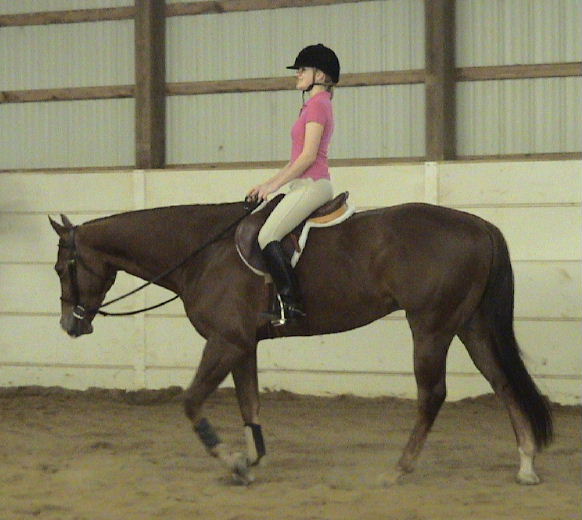
HUNT
SEAT EQUITATION
The rider, not the horse is judged in this event.
First the riders complete a prescribed pattern individually at the walk,
trot or canter. Then they ride as a group similar to in the hunter under
saddle class. The riderís body position and control of their horse are
evaluated. The pattern should be executed with grace and ease. There
rider should make the performance look effortless.
HUNTER UNDER SADDLE
Participants are in the arena together, and are
asked to walk, trot, canter and reverse at the direction of the judge.
While being judged, the horses stay on the perimeter of the arena and
then are usually brought to the middle of the arena to back for the
judge. Horses are evaluated on how well they move and how willingly
they accept commands from their riders. In this rail class a smooth
free-flowing stride is advantageous.
HUNTER HACK
Participants jump two fences individually then are
evaluated on the flat as in hunter under saddle. The horsesí way of
going and style over fences are considered.
5.
6 illnesses of the horse
Tetanus - Also referred to
as "lockjaw". Caused by a bacteria that lives in the soil.
This bacteria can enter the horse through open wounds. Symptoms
are muscle stiffness and a noticed stiffening of the face and jaw
muscles, hence the name "lockjaw". Mortality rate 80% (that means
that 80% of horse that get Tetanus die). Vaccination is
recommended.
Encephalomyelitis - Most
common stains are Eastern and Western Encephalomyelitis. These
viruses are introduced to the horse through mosquito bites.
Symptoms include fever, depression and loss of appetite. Mortality
rate is 50% for the Western strain and 80% for the Eastern strain.
Vaccination is recommended.
Influenza ~ This is a very
contagious illness that is spread from horse to horse. Symptoms
include cough, fever, nasal drainage, and loss of appetite.
Mortality rate is low. Vaccination is available.
West Nile Virus - This is
another form of Encephalomyelitis. Spread by mosquitoes that fed
on infected birds. This disease is not passed from horse to horse.
Symptoms include: fever, tremors, stumbling, and loss of appetite.
Mortality rate is 30%. Vaccination is recommended.
Strangles ~ Extremely
contagious but very treatable, Strangles is spread from horse to horse
by nose to nose contact or by the contamination of objects the injected
horse has touched with its nose. Symptoms are high fever and the
swelling of the lymph nodes under the jaw. Mortality rate is about
2% of treated cases and 15% in untreated cases. Vaccination is
recommended.
Rabies - Horse must be
bitten by infected animal. Very rare in equine but mortality is
100%. Vaccination is recommended.
6.
Definition of colic and symptoms
Colic results in
more equine deaths than any other illness. The mortality rate is about
11%.
Colic itself is not
a disease but a description of a severe stomach ache. The pain
associated with colic is usually based in the intestines or stomach.
Horses have a very fragile digestive tract and it can be upset by
numerous circumstances. All cases of colic should be monitored
closely. If any of the symptoms below are noticed a veterinarian
should be contacted immediately.
Symptoms include:
loss of appetite
rolling repeatedly
turning head
towards stomach or flank
getting in position
to urinate but not urinating
lying down and
getting up repeatedly
restlessness
sweating for not
reason
appearing to kick
at belly
breathing hard
while at rest
holding head in an
abnormal fashion
reduced bowel
movements
Prevention
Always provide
clean water, and plenty of roughage (hay). Do not overfeed grain
or high energy supplements. Be consistent in daily feeding
schedule by feeding at the same time and same amount every day.
Have a good de-worming program to prevent parasite infestation.
Click HERE to take Level V test
Click HERE to go back
to Online Lesson Program page
 Clean
water must be available at all times. An average horse will consume up
to 12 gallons of water daily, and even more when active. In the
winter horses prefer to drink warm (45-65 degrees) water. Horses can not eat enough snow to
have adequate water consumption.
Pasture
Clean
water must be available at all times. An average horse will consume up
to 12 gallons of water daily, and even more when active. In the
winter horses prefer to drink warm (45-65 degrees) water. Horses can not eat enough snow to
have adequate water consumption.
Pasture
 Good
quality pasture is always a great way to provide nutrition to a horse.
Although even on high quality pasture horses should be given a mineral
supplement. Horses on pasture only should be monitored closely for
weight loss and supplemented with hay and grain when the pasture is
going dormant or is over grazed.
Hay
Good
quality pasture is always a great way to provide nutrition to a horse.
Although even on high quality pasture horses should be given a mineral
supplement. Horses on pasture only should be monitored closely for
weight loss and supplemented with hay and grain when the pasture is
going dormant or is over grazed.
Hay
 An
average horse
eats about 10-15 pounds of hay daily (less if grazing on good quality
pasture). Two hay choices are available: grass hay and
legume hay. The most common hays fed are alfalfa (which is a legume
hay) and mixed grass hay. Alfalfa is high in protein and is
suitable for horse with extremely high energy demands. Grass hay
is lower in protein and is more suitable for average horses. Most grass hay can be fed free choice (unlimited
amount). Since horses require a high amount of roughage, high quality
grass hay is preferable. Of course each horse is an individual, some
horses may need restricted diets even on grass hay.
Grain
A fortified grain
mix can be fed in controlled quantities, based on horse's weight, age, and
activity level. Horses can not be fed grain free choice as they can
over eat and this can create a life threatening condition. Mature horses that are not active might not require
grain, although a good mineral supplement is required.
Minerals
Free
choice salt should be available for all horses or a mineral supplement for
horses fed only hay.
Some mineral supplements are not intended for horse consumption, only
feed horse specific supplements and salt blocks.
Frequency
An
average horse
eats about 10-15 pounds of hay daily (less if grazing on good quality
pasture). Two hay choices are available: grass hay and
legume hay. The most common hays fed are alfalfa (which is a legume
hay) and mixed grass hay. Alfalfa is high in protein and is
suitable for horse with extremely high energy demands. Grass hay
is lower in protein and is more suitable for average horses. Most grass hay can be fed free choice (unlimited
amount). Since horses require a high amount of roughage, high quality
grass hay is preferable. Of course each horse is an individual, some
horses may need restricted diets even on grass hay.
Grain
A fortified grain
mix can be fed in controlled quantities, based on horse's weight, age, and
activity level. Horses can not be fed grain free choice as they can
over eat and this can create a life threatening condition. Mature horses that are not active might not require
grain, although a good mineral supplement is required.
Minerals
Free
choice salt should be available for all horses or a mineral supplement for
horses fed only hay.
Some mineral supplements are not intended for horse consumption, only
feed horse specific supplements and salt blocks.
Frequency
 Horses
are grazing animals and should be fed at least twice daily to help
simulate their natural eating habits. This will encourage a
healthy digestive tract and help cut down on the instances of colic.
Horses
are grazing animals and should be fed at least twice daily to help
simulate their natural eating habits. This will encourage a
healthy digestive tract and help cut down on the instances of colic.

